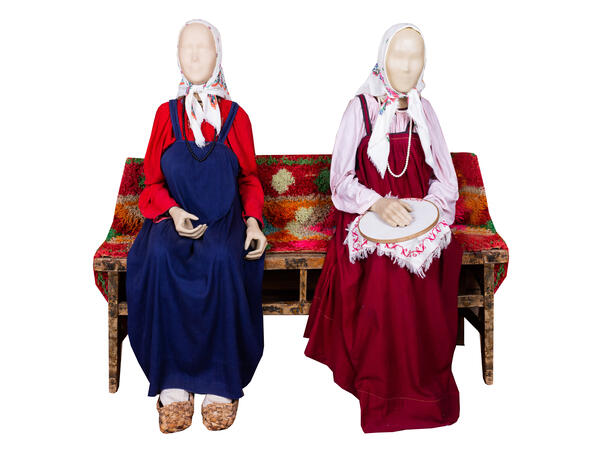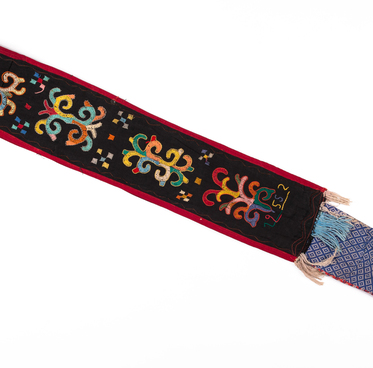The exposition at the Ethnography Hall has a Russian national women’s costume on display that was made in the 20th century. These are the clothes that Russian peasant women wore in everyday life. One of the most common items of women’s clothing is a long, spacious shirt, sewn using homespun fabrics. In terms of expensive, store-bought fabrics, usually chintz and silk were sewn on, and only the top of the shirt and sleeves. Over the shirt at home, they would wear a chintz, scrunched up skirt and an apron with frills, called a zapon. In factory settlements, long skirts with sweaters worn outside were also commonplace.
Sometimes, instead of a skirt, they would also wear a canvas sarafan, usually with blue or black coloring. Sarafans made from factory-made fabrics were considered to be holiday clothing. There were several types of sarafans. Until the middle of the 19th century, both buttoned-up and unfastened sarafans were in fashion, and then those were replaced by “Moscow-style” narrower, straight ones. A silk or brocade women’s padded coats called a telogreya - short, sleeveless clothing - was often worn over the sarafan.
In the clothing trunks used by Russian women many silk shawls, small-sized shawls, patterned knitted and lace scarves, kerchiefs, and headscarves could be found. Married women covered their hair with a small cloth cap (called either a povoinik or volosnik); in older women it had a dark color, while in younger women it was made of colored silk, chintz, or trimmed with lace. Some peasant women wore a silk or brocade headdress, called a kokoshnik or half-kokoshnik, for holidays. Those were considered to be wedding-day headdresses, which could be worn until the first child was born. Young girls weaved multi-colored ribbons into a braid, and tied a beaded band across their foreheads. Many women wore headscarves even before they went to bed.
Popular jewelry among Russian women included silver, copper, and gold earrings, rings, necklaces and collars made of beads; for some time, amber and glass beads and collar brooches were in fashion. During frosty winters, women’s street clothes were factory-made kaftans or a cloth jacket - called a chekmen - made of dark, homespun cloth, as well as sheepskin coats and cotton padded coats. Festive fur coats for rich villagers to go out on the town were covered with thin blue cloth or silk, and “on the sides seal or fox fur came down, with a fox or squirrel turn-down collar”.
The main work and everyday shoes for the majority of the Russian population were bast shoes. Women wore them with woolen stockings, and men with foot wrappings and strips of fabric to wrap around the feet; this was called an onucha. Well-off people bought boots or shoes.
Sometimes, instead of a skirt, they would also wear a canvas sarafan, usually with blue or black coloring. Sarafans made from factory-made fabrics were considered to be holiday clothing. There were several types of sarafans. Until the middle of the 19th century, both buttoned-up and unfastened sarafans were in fashion, and then those were replaced by “Moscow-style” narrower, straight ones. A silk or brocade women’s padded coats called a telogreya - short, sleeveless clothing - was often worn over the sarafan.
In the clothing trunks used by Russian women many silk shawls, small-sized shawls, patterned knitted and lace scarves, kerchiefs, and headscarves could be found. Married women covered their hair with a small cloth cap (called either a povoinik or volosnik); in older women it had a dark color, while in younger women it was made of colored silk, chintz, or trimmed with lace. Some peasant women wore a silk or brocade headdress, called a kokoshnik or half-kokoshnik, for holidays. Those were considered to be wedding-day headdresses, which could be worn until the first child was born. Young girls weaved multi-colored ribbons into a braid, and tied a beaded band across their foreheads. Many women wore headscarves even before they went to bed.
Popular jewelry among Russian women included silver, copper, and gold earrings, rings, necklaces and collars made of beads; for some time, amber and glass beads and collar brooches were in fashion. During frosty winters, women’s street clothes were factory-made kaftans or a cloth jacket - called a chekmen - made of dark, homespun cloth, as well as sheepskin coats and cotton padded coats. Festive fur coats for rich villagers to go out on the town were covered with thin blue cloth or silk, and “on the sides seal or fox fur came down, with a fox or squirrel turn-down collar”.
The main work and everyday shoes for the majority of the Russian population were bast shoes. Women wore them with woolen stockings, and men with foot wrappings and strips of fabric to wrap around the feet; this was called an onucha. Well-off people bought boots or shoes.



